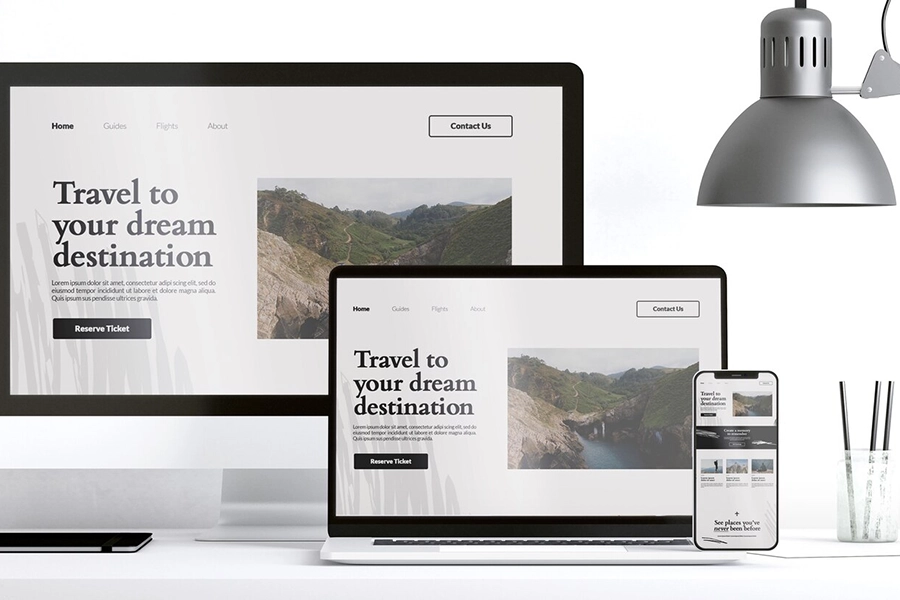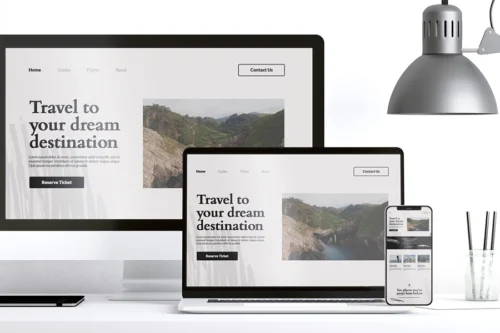Your business website is online, but it’s not getting the traffic or inquiries you hoped for. Many businesses face this issue, especially when starting out. But the good news is that with a few strategic tweaks, you can transform your website into a traffic magnet that converts visitors into customers.
Your Website’s SEO Needs Improvement
Search engine optimization (SEO) is essential for attracting traffic to your website. Without effective SEO, your site may never appear in search results for the keywords your customers are using.
Key SEO Issues to Address:
- Missing or Poorly Optimized Keywords: Ensure your website content includes keywords your audience is searching for.
- No On-Page Optimization: Meta tags, title tags, and headers should reflect primary keywords.
- Weak Content: Thin or low-quality content won’t engage readers or perform well in search results.
Solution: Focus on keyword research and content quality. Tools like Google Keyword Planner and Ahrefs can help identify keywords your audience is looking for.
Lack of Quality Content
Quality content attracts traffic and keeps visitors engaged. Without valuable content, potential customers may leave quickly or not visit at all.
Common Content Mistakes:
- Lack of Blog Posts: Regular blog updates help in ranking for multiple keywords and show industry expertise.
- Poorly Written or Unhelpful Content: Your content should address your customer’s pain points and offer solutions.
- Content Gaps: Cover relevant topics comprehensively to position your site as a trusted resource.
Solution: Develop a content strategy. Create helpful, in-depth articles, product guides, and FAQs that answer your customers’ questions.
Slow Website Speed
A slow-loading website drives visitors away. If your site takes more than a few seconds to load, visitors may leave before they see your content.
How to Improve Load Speed:
- Optimize Images: Large images can slow down your site. Compress images for faster loading.
- Minimize Code: Remove unnecessary scripts and plugins to speed up loading.
- Use a Reliable Hosting Service: A quality hosting provider can improve speed and uptime.
Solution: Test your site’s speed with tools like Google PageSpeed Insights, and make the recommended improvements.
Poor Mobile Experience
With mobile traffic on the rise, a website that’s not mobile-friendly can lose a large audience segment. If visitors can’t navigate easily on a mobile device, they’re less likely to engage or convert.
How to Improve Mobile Experience:
- Responsive Design: Ensure your website adjusts seamlessly on mobile devices.
- Clickable Buttons: Make sure buttons and links are easily clickable.
- Readable Text: Avoid tiny fonts; ensure text is readable without zooming.
Solution: Check your site’s mobile-friendliness using Google’s Mobile-Friendly Test and make adjustments as needed.
Poor Call-to-Action (CTA) Placement
Your website needs clear calls-to-action to guide visitors toward making an inquiry or purchase. If CTAs are missing, confusing, or placed ineffectively, users may not know how to take the next step.
CTA Optimization Tips:
- Use Clear Language: Make your CTA action-oriented, such as “Get a Free Quote” or “Contact Us Today.”
- Place CTAs Strategically: Place them above the fold and at the end of pages or blog posts.
- Experiment with Colors and Designs: Test different colors and designs to see which gets more clicks.
Solution: Use A/B testing to experiment with CTA placement, color, and language to find what works best.
Lack of Social Proof
People trust reviews, testimonials, and case studies. If your website lacks social proof, visitors may hesitate to reach out, doubting your credibility.
Ways to Add Social Proof:
- Customer Testimonials: Display feedback from satisfied clients.
- Case Studies: Showcase successful projects or outcomes.
- Trust Badges: Highlight affiliations, certifications, or awards.
Solution: Place testimonials, logos, and case studies prominently on your homepage and service pages.
Not Investing in Paid Advertising
While organic traffic is valuable, paid ads can bring in immediate traffic, especially when your website is new. Without any advertising, it can take months to see organic results.
Types of Paid Advertising:
- Google Ads: Target specific search terms that are relevant to your business.
- Social Media Ads: Reach your audience on platforms like Facebook, Instagram, and LinkedIn.
- Retargeting Ads: Re-engage visitors who previously visited your site but didn’t convert.
Solution: Set a small budget to run ads and monitor their performance. Optimize your ad strategy over time to maximize results.
Neglecting Analytics
Not tracking website traffic and user behavior means you’re missing critical data that can help improve your website. Analytics can reveal where your traffic is coming from, what pages visitors are viewing, and where they’re dropping off.
Key Metrics to Monitor:
- Bounce Rate: High bounce rates indicate issues with user engagement.
- Conversion Rate: Measure how many visitors turn into leads or customers.
- Source of Traffic: Understand where your traffic is coming from to optimize your marketing channels.
Solution: Use Google Analytics to track metrics, and make data-driven adjustments to improve user experience.
Not Using User Behavior Analytics to Improve Engagement
To understand why visitors might not be engaging or converting on your site, it’s crucial to use tools that track user behavior. Behavior analytics tools provide visual insights, such as heatmaps, session recordings, and interaction data, allowing you to see exactly how users navigate your site and where they may encounter friction. This information helps you make data-driven improvements that can lead to more inquiries and conversions.
Key Benefits of Using Behavior Analytics
- Heatmaps: Heatmaps show which areas of your website get the most attention, helping you identify where users click, hover, or scroll. This insight can help you place critical information where it’s most likely to be seen and interacted with.
- Session Recordings: By watching real user sessions, you can observe how visitors navigate through your site and where they encounter problems or leave. This allows you to directly identify any confusing elements or navigation issues.
- Click Patterns and Scroll Depth: With click and scroll data, you can learn how far users scroll on each page and where they tend to click. If important information is missed because users aren’t scrolling far enough, you may need to adjust your page layout.
- Interaction Issues: Analytics tools often detect issues like “rage clicks” (repeated clicks on an element out of frustration) or “dead clicks” (clicks on non-functional elements). These indicators can show where users are getting frustrated, allowing you to quickly address the problem areas.
Solution: Install a behavior analytics tool on your site to better understand how visitors engage with each page. By analyzing these insights, you can enhance user experience, ensure critical elements are visible, and optimize conversion paths to boost inquiries.
Why is my business website not getting traffic?
A lack of SEO, low-quality content, poor user experience, and no advertising budget are common reasons business websites struggle to attract traffic.
How can I increase inquiries on my website?
Improve CTA placement, provide clear contact options, and ensure a mobile-friendly design. Using social proof and clear service descriptions can also help.
Do I need a blog to increase website traffic?
Yes, a blog helps your website rank for relevant keywords, provides value to your audience, and positions your brand as an authority in your field.
By addressing these areas, you can turn your website into a traffic-driving machine that converts visitors into inquiries and new customers. A consistent focus on SEO, user experience, and quality content will pay off as your website attracts more traffic and generates more leads over time.






